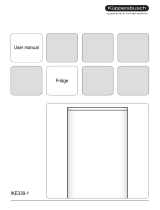
1.6 Smart device
The appliance is ready for integration into a smart
home and for extended services. Other options can
be selected with a SmartDeviceBox. This is acti-
vated via the MyLiebherr customer portal.
You will find more information about availability and pre-requi-
sites and the individual options on the website www.smartde-
vice.liebherr.com.
2 General safety information
Danger for the user:
-
This appliance can be used by children of 8
years old and over, and also by persons with
restricted physical, sensory or mental
capacity or lack of experience and knowl-
edge, if they are supervised or have been
instructed on safe use of the appliance and
understand the resulting risks. Children must
not be allowed to play with the appliance.
Cleaning and user maintenance must not be
carried out by children without supervision.
-
When disconnecting the appliance from the
supply, always take hold of the plug. Do not
pull the cable.
-
In the event of a fault pull out the mains plug
or deactivate the fuse.
-
Do not damage the mains power cable. Do
not operate the appliance with a defective
mains power cable.
-
Have any repairs to or intervention in the
appliance, and any change of the mains
power cable, carried out by the customer
service only or by other specialised personnel
trained for the purpose.
-
Only assemble, connect and dispose of the
appliance according to the instructions.
-
Please keep these instructions in a safe place
and pass them on to any subsequent owners.
-
Special-purpose lamps (incandescent lamps,
LEDs, fluorescent tubes) in the appliance
serve to illuminate the appliance interior and
are not suited for room illumination.
Fire hazard:
-
The refrigerant R 600a is environmentally
friendly but flammable. Escaping refrigerant
may ignite.
•
Do not damage the refrigerant circuit pipes.
•
Do not allow naked flames or ignition
sources to enter the appliance.
•
Do not use any electrical appliances in the
interior (e.g. steam cleaners, heaters, ice
cream maker etc.).
•
If refrigerant escapes: remove any naked
flames or sources of ignition from the
leakage area. Ventilate the room well.
Notify the after-sales service.
-
Do not store explosives or sprays using
combustible propellants such as butane,
propane, pentane, etc. in the appliance. To
identify these spray cans, look for the list of
contents printed on the can, or a flame
symbol. Gases possibly escaping may ignite
due to electrical components.
-
Keep burning candles, lamps and other items
with naked flames away from the appliance
so that they do not set the appliance on fire.
-
Please be sure to store alcoholic drinks or
other packaging containing alcohol in tightly
closed containers. Any alcohol that leaks out
may be ignited by electrical components.
Danger of tipping and falling:
-
Do not misuse the plinth, drawers, doors etc.
as a step or for support. This applies particu-
larly to children.
Danger of food poisoning:
-
Do not consume food which has been stored
too long.
Danger of frostbite, numbness and pain:
-
Avoid lasting skin contact with cold surfaces
or refrigerated/frozen food or take protective
steps, e.g. wear gloves. Do not consume ice
cream, water ice or ice cubes immediately
and do not consume them too cold.
Danger of injury and damage:
-
Hot steam can lead to injury. Do not use elec-
trical heating or steam cleaning equipment,
open flames or defrosting sprays to defrost.
-
Do not use sharp implements to remove the
ice.
Danger of crushing:
-
Do not hold the hinge when opening and
closing the door. Fingers may get caught.
Symbols on the appliance:
The symbol can be located on the compressor. It
refers to the oil in the compressor and indicates
the following danger: Swallowing or inhaling can
be fatal. This is only relevant for recycling. There
is no danger in normal operation.
Please observe the specific information in
the other sections:
DANGER identifies a situation involving direct
danger which, if not obviated, may
result in death or severe bodily
injury.
General safety information
4 * Depending on model and options



















